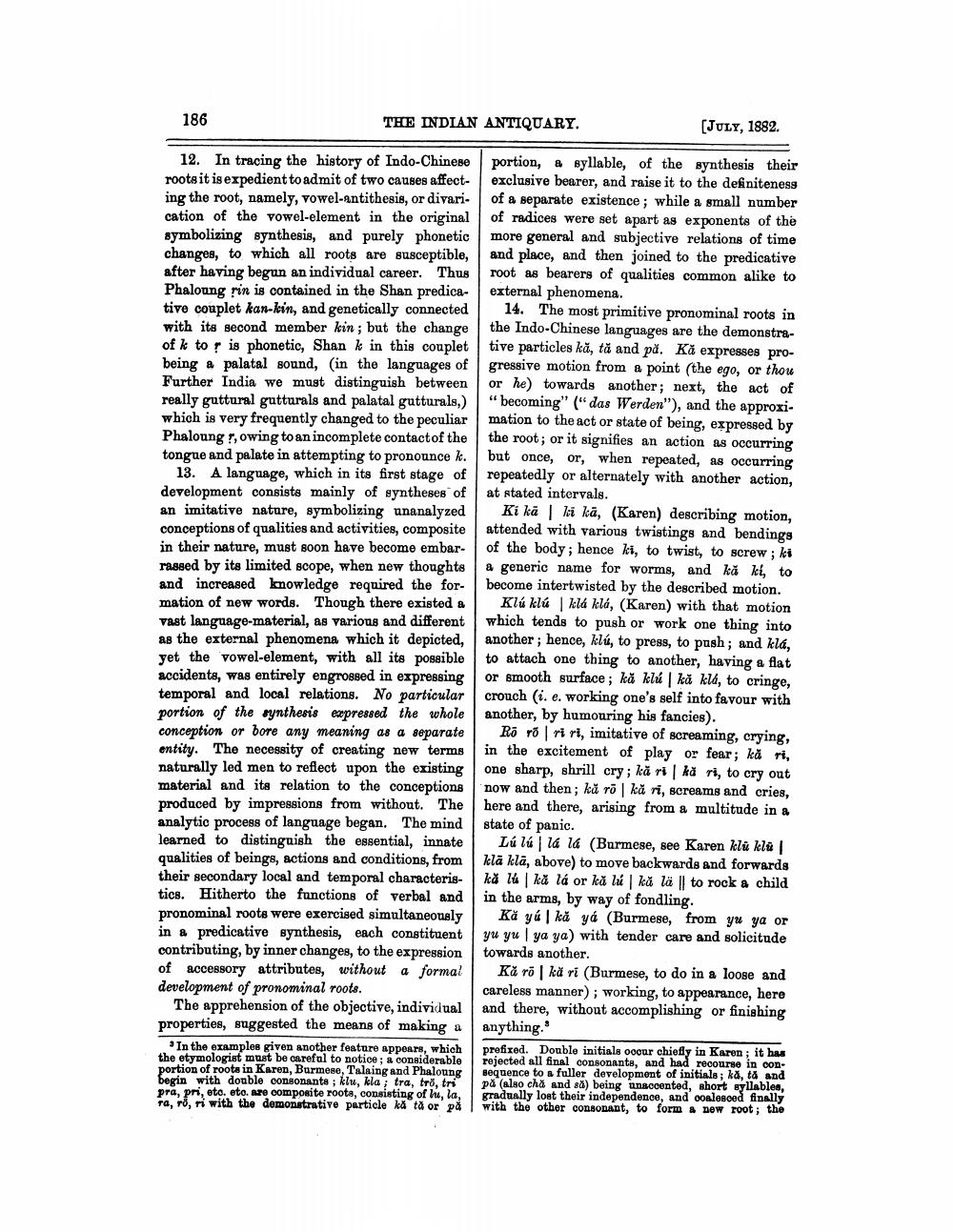________________
186
THE INDIAN ANTIQUARY.
[JULY, 1882.
12. In tracing the history of Indo-Chinese portion, a syllable, of the synthesis their roots it is expedient to admit of two causes affect- exclusive bearer, and raise it to the definiteness ing the root, namely, vowel-antithesis, or divari. of a separate existence; while a small number cation of the vowel-element in the original of radioes were set apart as exponents of the symbolizing synthesis, and purely phonetic more general and subjective relations of time changes, to which all roots are susceptible, and place, and then joined to the predicative after having began an individual career. Thus root as bearers of qualities common alike to Phaloung rin is contained in the Shan predica- external phenomena. tive couplet kan-kin, and genetically connected 14. The most primitive pronominal roots in with its second member kin; but the change the Indo-Chinese languages are the demonstraof k tor is phonetic, Shan k in this couplettive particles kā, tā and på. Ka expresses probeing a palatal sound, in the languages of gressive motion from a point (the ego, or thou Further India we must distinguish between or he) towards another; next, the act of really guttural gutturals and palatal gutturals) “becoming" ("das Werden"), and the approxiwhich is very frequently changed to the peculiarmation to the act or state of being, expressed by Phaloung?, owing to an incomplete contactof the the root; or it signifies an action as occurring tongue and palate in attempting to pronounce k. but once, or, when repeated, as occurring
13. A language, which in its first stage of repeatedly or alternately with another action, development consists mainly of syntheses of at stated intervals. an imitative nature, symbolizing unanalyzed Ki kaki kā, (Karen) describing motion, conceptions of qualities and activities, composite attended with various twistings and bendings in their nature, must soon have become embar- of the body; hence ki, to twist, to screw; ki rassed by its limited scope, when new thoughts & generic name for worms, and kă ki, to and increased knowledge required the for- become intertwisted by the described motion. mation of new words. Though there existed a Klú klú klá klá, (Karen) with that motion vast language-material, as various and different which tends to push or work one thing into as the external phenomena which it depicted, another; hence, klú, to press, to push ; and klá, yet the vowel-element, with all its possible to attach one thing to another, having a flat accidents, was entirely engrossed in expressing or smooth surface; k, klókklá, to cringe, temporal and local relations. No particular crouch (i. e. working one's self into favour with portion of the synthesis expressed the whole another, by humouring his fancies). conception or bore any meaning as a separate Rō rori ri, imitative of screaming, crying, entity. The necessity of creating new terms in the excitement of play or fear; kā ri, naturally led men to reflect upon the existing one sharp, shrill cry; kā ri ka ri, to cry out material and its relation to the conceptions now and then; kò ro kă ri, screams and cries, produced by impressions from without. The here and there, arising from a multitude in a analytic process of language began. The mind state of panic. learned to distinguish the essential, innate Lú lú lá lá (Burmese, see Karen klukla qualities of beings, actions and conditions, from kla klä, above) to move backwards and forwards their secondary local and temporal characteris- ko lukea lá or ka lúka lä | to rock a child tics. Hitherto the functions of verbal and in the arms, by way of fondling. pronominal roots were exercised simultaneously Kå yú kă yé (Burmese, from yr ya or in a predicative synthesis, each constituent yu yu ya ya) with tender care and solicitude contributing, by inner changes, to the expression towards another. of accessory attributes, without a formal Kā roka ri (Burmese, to do in a loose and development of pronominal roots.
careless manner); working, to appearance, here The apprehension of the objective, individual and there, without accomplishing or finishing properties, suggested the means of making a anything."
In the examples given another feature appears, which prefixed. Double initials ooour chiefly in Karen ; it has the etymologist must be careful to notice; a considerable rejected all final consonante, and had recourse in conportion of roots in Karen, Burmese. Talaing and Phaloung sequence to a fuller development of initials; ka, ta and begin with double consonants; klu, kla; tra, tro, tri på (also cha and $8) being unaccented, short syllables, pra, pri, etc. etc. are composite roots, consisting of the, la, gradually lost their independence, and coalesced finally ra, 78, ri with the demonstrative particle ka tå or på with the other consonant, to form a new root; the




